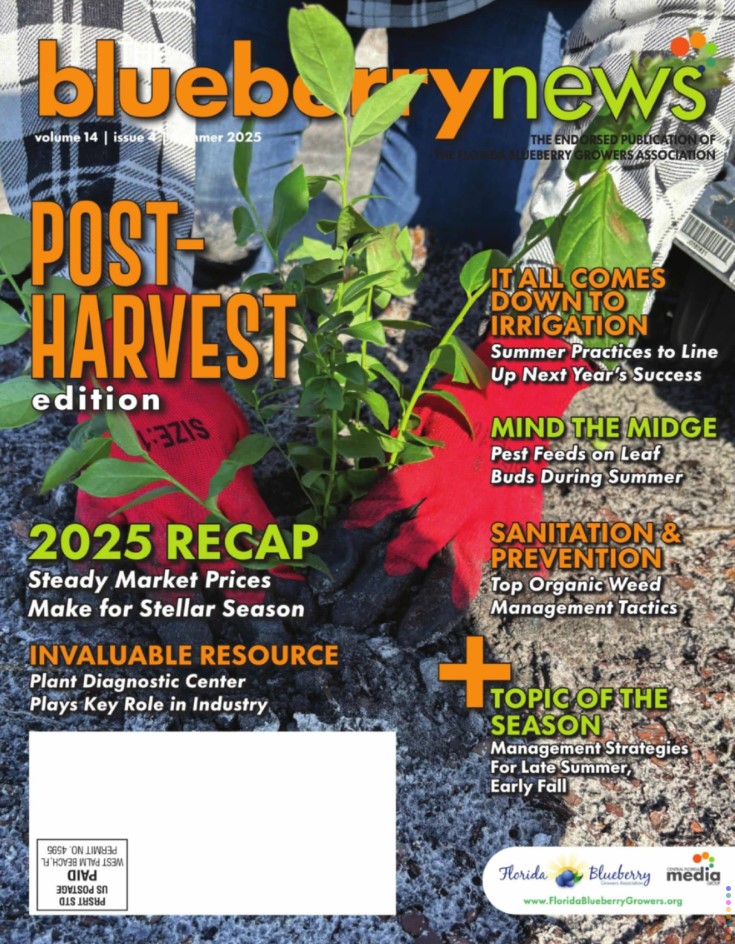Evaluating How Various Cultivars Respond to the Agent
Credits: Jacob Buck, graduate student; Jeff Williamson, professor; and Gerardo Nunez, assistant professor, Horticultural Sciences Department, IFAS, University of Florida
Southern highbush blueberry (Vaccinium corymbosum interspecific hybrids) cultivars require a period of chilling at temperatures around 45°F for proper dormancy release. Adequate chill accumulation is necessary for synchronous flowering and concentrated harvest. Growers are often challenged with suboptimal chill that may be further exacerbated by global climate change. Hydrogen cyanamide (HC) is a dormancy-breaking agent commonly used to mitigate the negative effects of insufficient chill accumulation in Florida. New cultivars are continuously developed and released by the University of Florida’s blueberry breeding program. Since cultivars vary in their sensitivity and response to HC, it is important to evaluate each new cultivar to determine HC tolerance, potential benefits, and if it is a good candidate for HC use. On tolerant and responsive cultivars, proper timing and concentration of HC can accelerate leaf canopy development, advance harvest date, and increase fruit size.
Two experiments were conducted at Straughn Farms in Waldo from 2019-2021. The first investigated the effect of different rates of HC on bud break and yield in cultivars “Optimus” and “Colossus.” The experiment was repeated over two growing seasons on 3- to 4-year-old blueberry bushes. Plants were sprayed to drip towards the end of December with a foliar application of HC in the form of Dormex at a rate of 0.75%, 1.00%, 1.25%, or 1.5%. A non-sprayed control was used for comparison. The second experiment investigated the timing of application using 1.25% Dormex. Two-year-old bushes of cultivars “Optimus,” “Colossus,” “Sentinel,” and “Magnus” were utilized. Dormex was applied after 50, 100, 150, or 200 hours of chill accumulation with a non-sprayed control for comparison. The timing experiment was conducted over one growing season but will be repeated in spring 2022. For both experiments, vegetative and reproductive bud development were tracked over the growing seasons along with flower bud mortality, fruit set, yield, berry size and fruit quality.
Higher Dormex rates (1.25% and 1.5%) accelerated vegetative bud development. Reproductive bud development was accelerated in “Colossus,” but slowed down in “Optimus.” Regardless of reproductive bud development, “Colossus” yield was advanced on the first harvest date and “Optimus” yield was advanced on the first three harvest dates. Higher rates (e.g. 1.5%) were also associated with higher levels of flower bud mortality. In the timing experiment, higher chill accumulation (e.g. 150- and 200-hour treatments) led to earlier vegetative bud break as well as higher levels of flower bud mortality across all cultivars except “Sentinel.” Fruit harvest was only advanced in “Optimus” by the 150-hour treatment. Generally, larger berries were observed as a consequence of high chill hour accumulation in all cultivars. A summary of this work will be presented at the FBGA Fall Blueberry Short Course.





